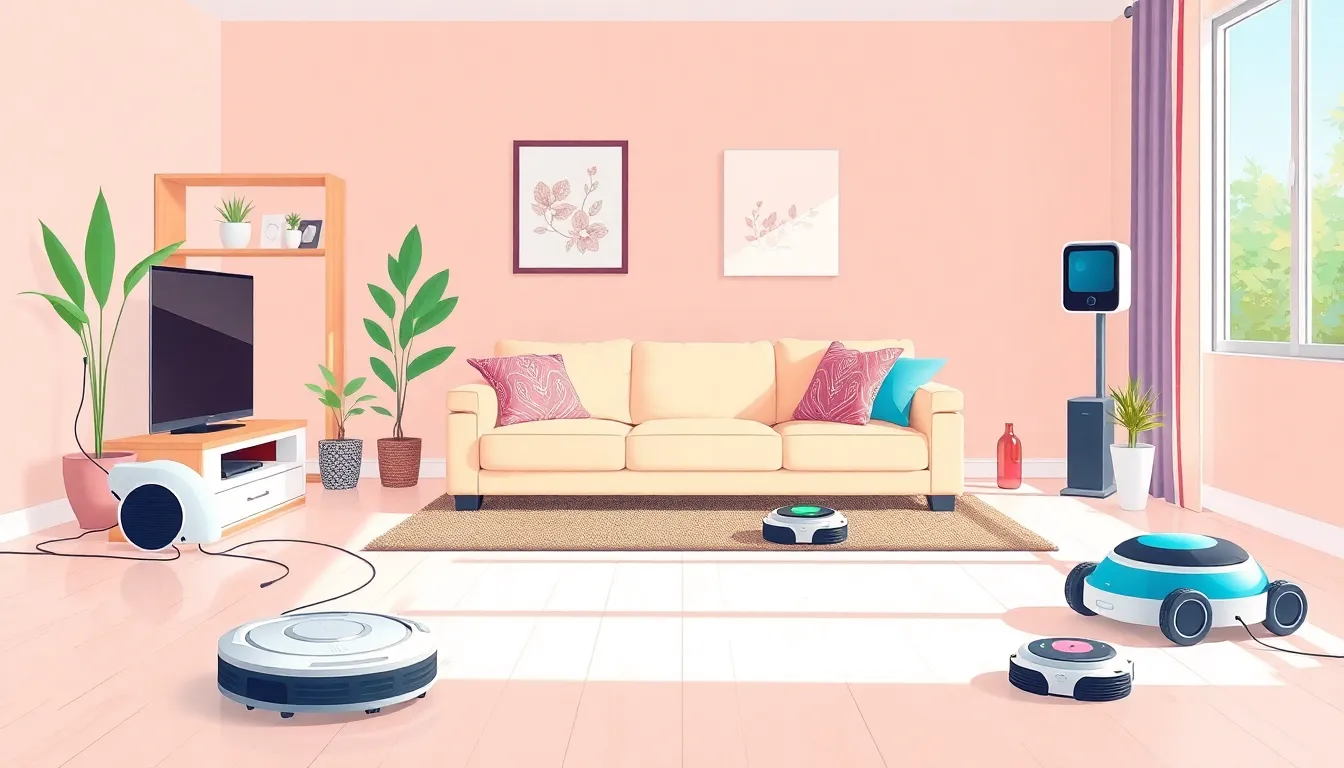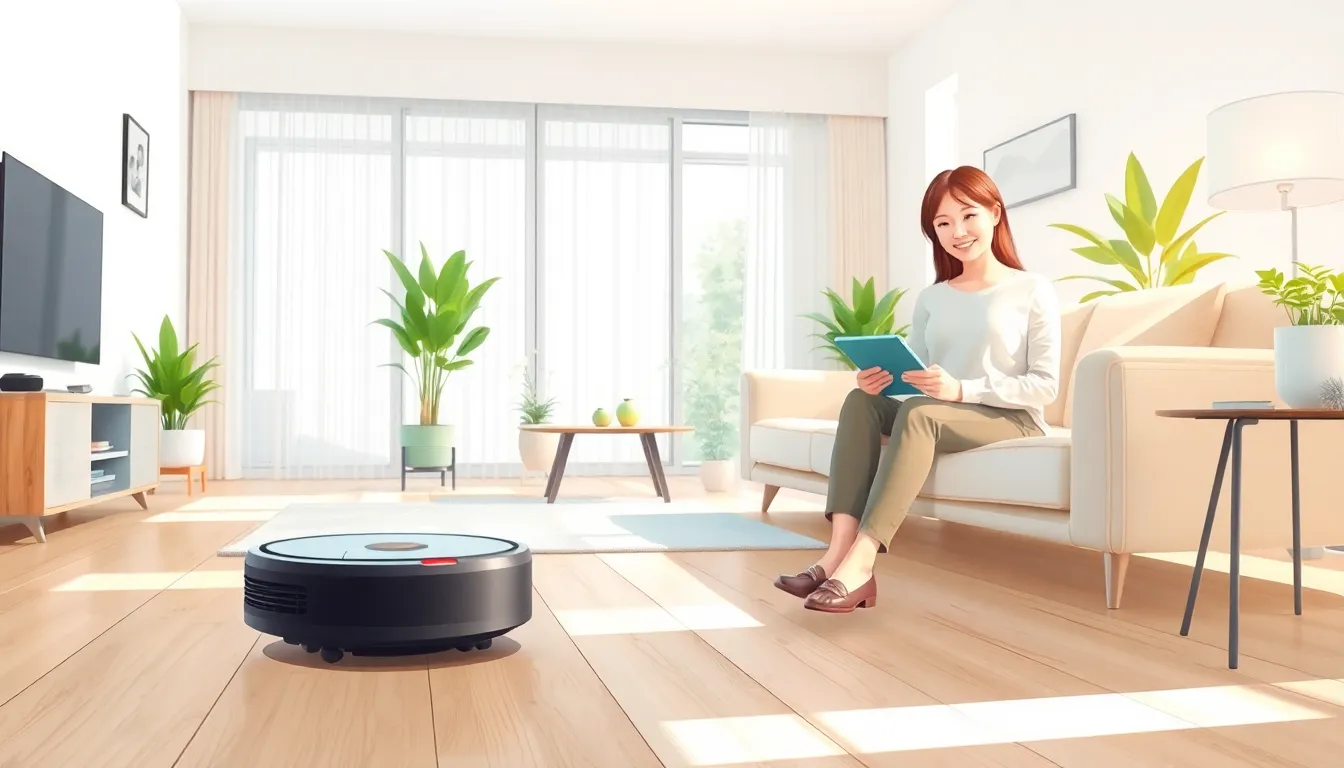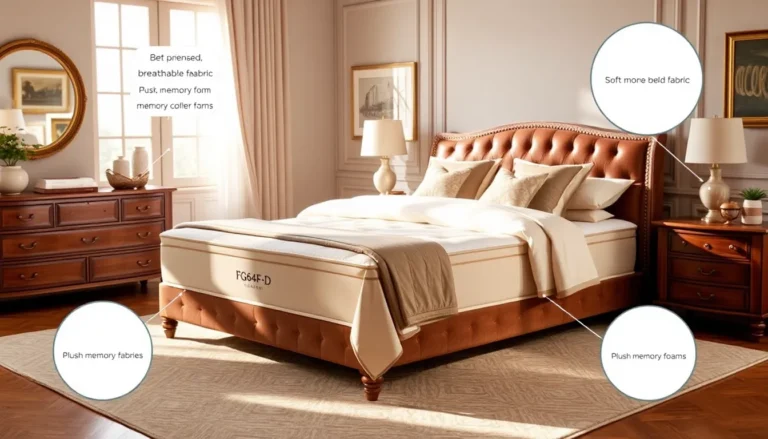Imagine a world where your vacuum cleaner doesn’t just suck up dirt but also engages in witty banter while doing it. Automated home robotics are transforming the mundane tasks of daily life into a futuristic experience. Gone are the days of wrestling with a broom or arguing with your mop; now, your home can run like a well-oiled machine—all while you kick back and binge-watch your favorite shows.
These clever gadgets aren’t just for show. They’re designed to save time, reduce stress, and even add a sprinkle of fun to household chores. From robotic vacuums that dodge furniture like ninja warriors to smart assistants that remind you to water your plants, the future of home management is here. Get ready to embrace the convenience of automation and let these little helpers take the reins while you enjoy the sweeter things in life.
Table of Contents
ToggleOverview Of Automated Home Robotics
Automated home robotics encompasses a variety of devices designed to assist with household tasks. These machines, ranging from robotic vacuums to smart assistants, enhance convenience and efficiency in daily routines. Robotic vacuums autonomously navigate spaces, identifying and avoiding obstacles while cleaning floors. Smart assistants, equipped with voice recognition, manage calendars and control smart home devices with simple commands.
Efficiency remains a pivotal aspect of these technologies. Data reveals that robotic vacuums can reduce cleaning time by up to 70%. Many households benefit from this time-saving feature, allowing family members to engage in leisure activities instead of chores. Additionally, some robotic devices integrate advanced sensors, making them reliable in handling various surfaces and challenging layouts.
Robotics in homes also feature impressive connectivity. Smart assistants connect with multiple devices, allowing users to adjust lighting, thermostat settings, and security systems through voice commands. This interconnectedness contributes to a seamless experience, promoting a smarter living environment.
Safety is another critical consideration. Automated home robotics include features that protect homes by monitoring for intruders or alerting users to smoke or water leaks. This added layer of security provides peace of mind, ensuring homes remain safe while occupants focus on other endeavors.
Customization options further enhance the appeal of automated technologies. Many robotic devices allow users to schedule cleaning times or adjust settings according to personal preferences. These personalized functionalities cater to individual lifestyles, underscoring the significant adaptability of automated home robotics in modern living spaces.
Types Of Automated Home Robots

Various types of automated home robots significantly enhance daily life. These devices improve efficiency and add convenience in multiple areas.
Vacuum Cleaning Robots
Vacuum cleaning robots autonomously navigate floors, offering a hands-free cleaning solution. They utilize advanced sensors to detect dirt and debris, optimizing cleaning paths effectively. Many models feature programmable schedules, allowing users to set cleaning times based on their specific preferences. Battery life typically ranges from 60 to 120 minutes, depending on the model’s suction power and cleaning efficiency. Users often report a substantial reduction in cleaning time, with some estimates suggesting a decrease of up to 70%. Their compact designs let them easily reach under furniture and in tight spaces, enhancing home cleanliness overall.
Lawn Mowing Robots
Lawn mowing robots automate the tedious task of lawn care. Equipped with sharp blades and sophisticated navigation systems, they can manage various terrains effectively. Many models allow users to define boundaries using boundary wires or GPS technology, ensuring precise mowing patterns. Operating on a schedule means lawns stay neatly trimmed, enhancing curb appeal with minimal effort. Robot mowers typically need charging after working for 60 to 90 minutes. Some advanced versions include weather sensors to avoid mowing during rain, contributing to lawn health.
Security Robots
Security robots add a layer of protection to homes with monitoring capabilities. These devices patrol designated areas, using cameras and motion sensors to detect potential threats. Many models send real-time alerts to users’ smartphones when unusual activity occurs. Increased functionality includes facial recognition and two-way audio for communication. Some security robots operate autonomously, while others can be remotely controlled. Cloud storage often archives footage, providing valuable evidence in case of incidents. Enhanced safety features help ensure peace of mind for homeowners.
Benefits Of Using Automated Home Robotics
Automated home robotics offer significant advantages that enhance daily living. These devices transform customary routines, allowing individuals to focus on more enjoyable activities.
Time Savings
Robotic vacuums can cut cleaning time by up to 70%. Scheduling tasks through apps gives homeowners flexibility while ensuring a consistently clean environment. Smart assistants streamline managing appointments and reminders. Individuals gain more leisure time, as these gadgets tackle time-consuming chores autonomously. Overall, investing in automated home robotics frees up hours each week for family, hobbies, or relaxation.
Enhanced Security
Security robots patrol properties, monitoring for potential intruders. Real-time alerts keep homeowners informed of unusual activity. Advanced features such as facial recognition provide additional layers of safety. These devices can monitor indoor and outdoor spaces, ensuring comprehensive surveillance. Automated home robotics significantly enhance peace of mind, allowing individuals to feel secure in their homes.
Increased Efficiency
Automated home devices execute tasks with precision and consistency. For example, lawn mowing robots maintain grass at an optimal height, promoting better growth. Smart home systems integrate various devices, creating a cohesive and efficient living environment. Energy-efficient appliances reduce utility costs while performing necessary tasks. Overall, automated home robotics optimize household operations, making daily life smoother.
Challenges And Limitations
Automated home robotics face various challenges and limitations that impact their efficiency and accessibility.
Cost Considerations
Investing in automated home robots often involves significant upfront costs. Many high-quality robotic devices can range from $200 to over $1,500, depending on their features and capabilities. While these investments save time and effort, potential buyers must weigh long-term savings against initial expenses. Maintenance costs can also accumulate, as robotic devices may require occasional repairs or battery replacements. For homeowners on a budget, exploring lower-priced alternatives might yield devices with fewer features or capabilities, leading to a gap in effectiveness.
Technical Limitations
Automated home robotics come with inherent technical limitations that hinder their performance. Navigation systems may struggle in complex or cluttered environments, leading to incomplete cleaning tasks. Sensors might not detect low-profile obstacles, affecting efficiency. Additionally, connectivity issues can disrupt communication between devices, impacting functionality. Software updates may introduce new problems, as compatibility varies among manufacturers. Such technical challenges can lead to frustration for users, who expect seamless operation from their automated devices.
Future Of Automated Home Robotics
Innovations in automated home robotics continue to shape the future of household management. Advancements in artificial intelligence and machine learning lead to enhanced capabilities for robots, creating more intuitive interactions for users. Emerging technologies, such as advanced sensors and better battery life, enable these devices to perform tasks with greater efficiency and reliability.
Robots designed for specific functions are expected to gain popularity. For instance, lawn mowing robots might integrate weather forecasting features, allowing them to operate optimally depending on incoming weather patterns. Likewise, smart robots can offer advanced integration with other home automation systems, making management seamless and user-friendly.
In addition to improvements in functionality, costs are becoming more accessible for the average consumer. The market for automated home robotics is projected to expand significantly, anticipated to reach a value of $35 billion by 2027. As more manufacturers enter this space, competition drives innovation and lowers prices, making these technologies more accessible to a broader audience.
Safety and security enhancements remain a priority. Developers are focusing on features like real-time surveillance and remote monitoring capabilities to meet rising consumer concerns about home safety. These advancements provide peace of mind when away from home, knowing that automated systems are actively monitoring surroundings.
Sustainability is increasingly becoming a focal point in home robotics. Manufacturers are investing in eco-friendly materials and energy-efficient designs that reduce environmental impact while delivering performance. The transition to greener options resonates with consumers seeking responsible choices in technology.
Overall, the future of automated home robotics looks promising, combining convenience, safety, and sustainability seamlessly. As these innovations continue to evolve, they hold the potential to transform home management into a more effortless experience.
Automated home robotics are reshaping the way people manage their households. These innovative devices not only save time but also enhance security and efficiency. As technology continues to evolve, users can expect even more sophisticated features that cater to their specific needs.
The growing accessibility of these gadgets promises to make home automation a reality for many. With ongoing advancements in AI and machine learning, the future of automated home robotics looks bright. Embracing this technology can lead to a more relaxed and enjoyable home environment.



